Featured Comment:
“I made this dish following the recipe with no deviations and it came out great! Thank you for posting!”
– Nicholas Kotsianas
What is Ebi Chili?
Ebi chili is a popular dish with juicy stir-fried shrimp in a vibrant sweet and spicy sauce. The dish is a type of “chuka ryori” (Chinese-inspired Japanese dish) and a popular appetizer in many Chinese restaurants in Japan. It is typically served with steamed rice or noodles.
In Japanese, “ebi” (エビ) means shrimp and “chili” comes from the English “chili pepper”. Despite its vivid red color and use of “chili” in the name, Japanese ebi chili is actually not that spicy. Japanese people are known for not being so good with very spicy foods, so ebi chili is not as spicy as you might expect!
I’m actually a big fan of hot and spicy foods so my ebi chili recipe is a little hotter than what you might find in Japan, however, you can easily adjust the spice level to suit your tastes! I’ll explain how in the recipe.
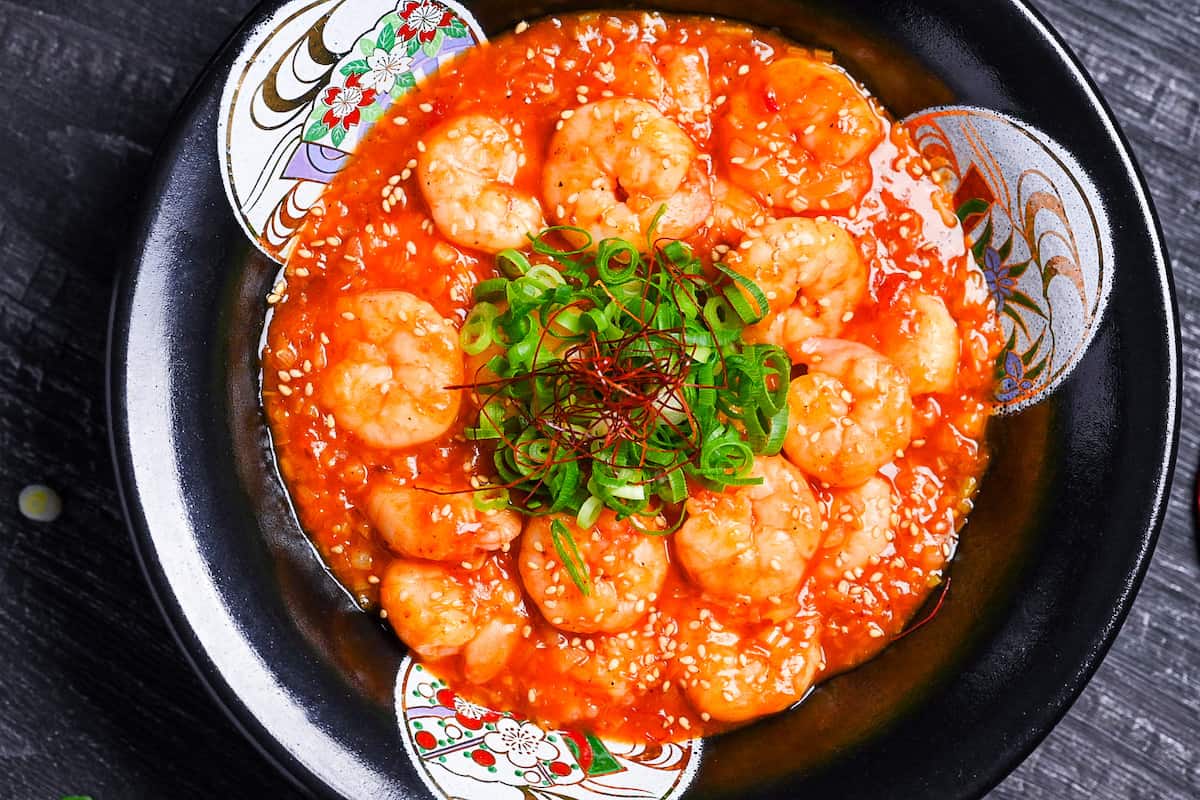

How I Developed This Recipe
I wanted to make this Ebi Chili recipe taste just like the ones you’d find in Chinese restaurants in Japan. Finding that perfect balance of spiciness and sweetness was the key.
After trial and error, I got the blend of ingredients just right to create that signature taste!
I think you’ll find that this dish is just as good as what you’d get in a restaurant!
Ingredients & Substitution Ideas

- Shrimp: Medium to large shrimps, like whiteleg shrimps (often called king prawns) and giant tiger prawns, give the best results. Don’t forget to devein them for a cleaner and smoother taste. Tails can be left intact according to preference.
- Salt and Cornstarch: Used to clean the shrimp, improving flavor and texture.
- Aromatics: Finely dice fresh ginger and garlic cloves to flavor the oil and carry maximum flavor throughout the whole dish.
- Spring Onion: The white part is fried with the aromatics, while the green part is thinly sliced and used as a garnish to add a pop of color at the end. Check out my guide on green onions for cutting tips and techniques.
- Ketchup: A key ingredient that softens the spice and adds sweetness and a gentle tanginess to suit Japanese tastes.
- Chinese Chili Bean Paste (Tobanjan): This is the secret behind that spicy, deep and flavorful ebi chili sauce.
- Chinese Chicken Bouillon Powder: Adds depth, umami and a subtle saltiness that works perfectly with Asian style dishes.
- Seasonings: A pinch of sea salt, freshly ground black pepper and white sugar help balance and bring out the flavors of the dish.
- Slurry: A simple slurry made with cornstarch and water helps make the sauce thick and glossy. Potato starch or tapioca starch can be used as substitutes. Avoid adding any starch directly to the sauce as this can cause lumps.
- Garnish: Sesame seeds and chili threads are optional but make a great final touch for presentation.
Curious about the exact brands and products that bring my recipes to life? Discover the brands and ingredients behind my recipes at the Sudachi Amazon Storefront. Explore my handpicked pantry essentials and find your next kitchen favorites!
Jump to Full Recipe Measurements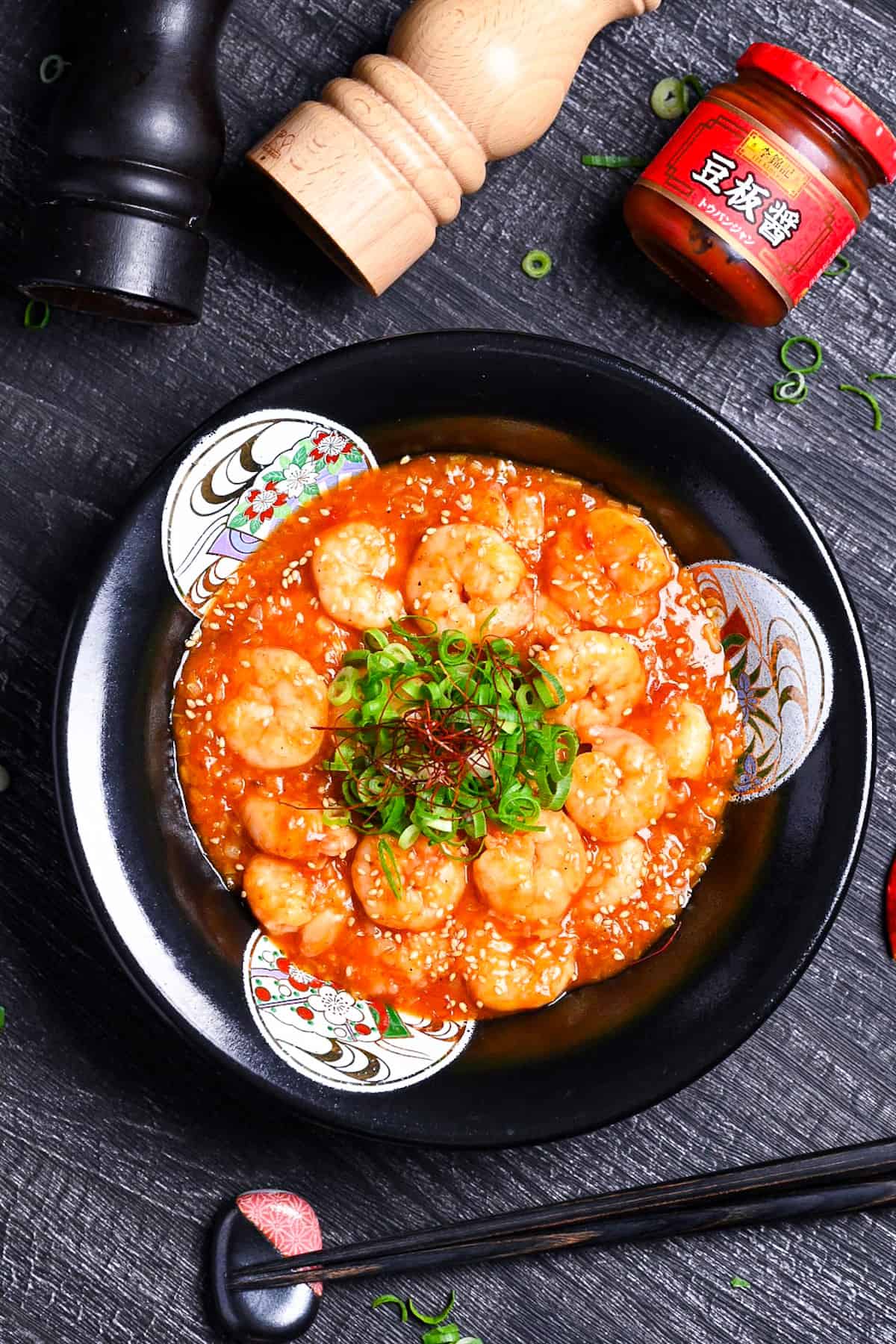
Visual Walkthrough & Tips
Here are my step-by-step instructions for how to make Ebi Chili at home. For ingredient quantities and simplified instructions, scroll down for the Printable Recipe Card below.

The first step is to remove the shells. Use your fingers to split the shell in the middle and gently pull it off. You can keep the tail intact if you like, tails are sometimes left on for presentation (they also add more depth to the sauce).

Use a sharp knife to cut down the back of the shrimp and reveal the vein. You can pull it out using the tip of the knife, a toothpick or a deveining tool.
If you don’t want to cut the shrimp, you can use a toothpick to pierce the middle, hook the vein and pull it out. There is a chance it will snap if you do this, so I recommend taking your time and being quite gentle with this method.
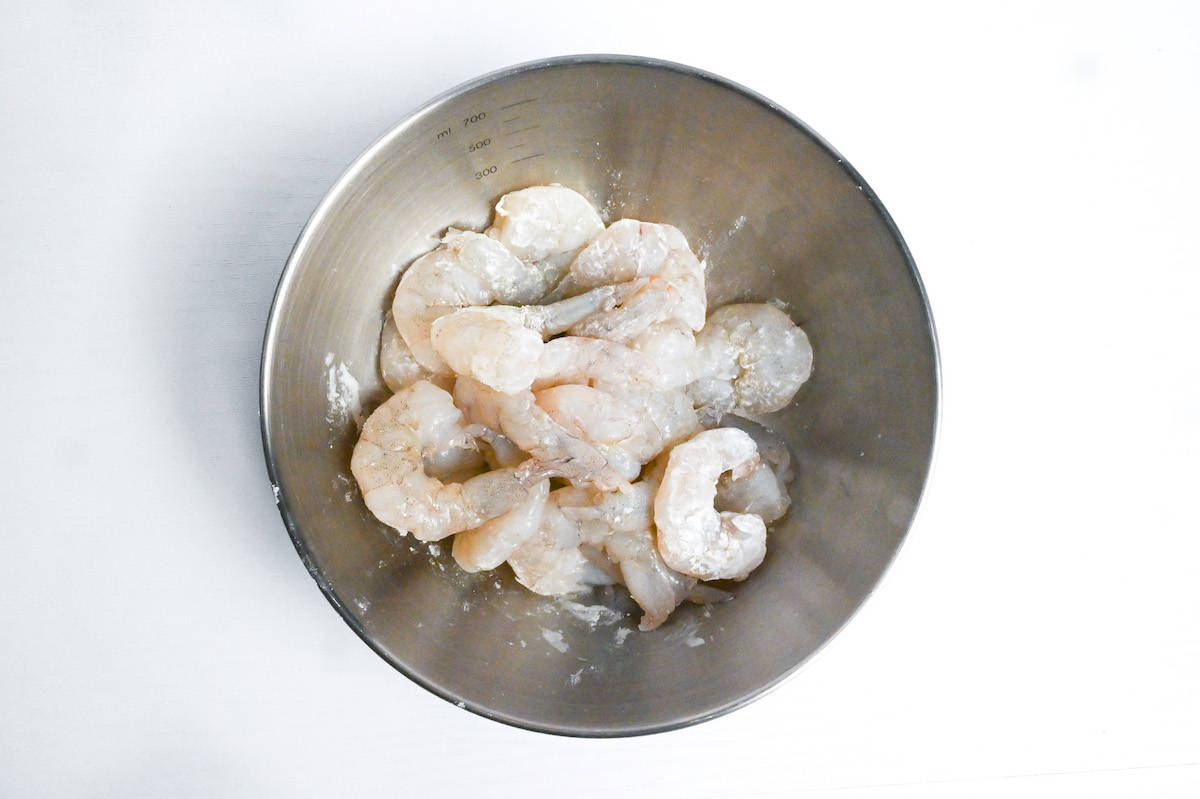
Clean the shrimp by placing them in a bowl of water and rubbing the surface with 1 tsp of cornstarch and a few pinches of salt. Once fully covered, rest for a few minutes.
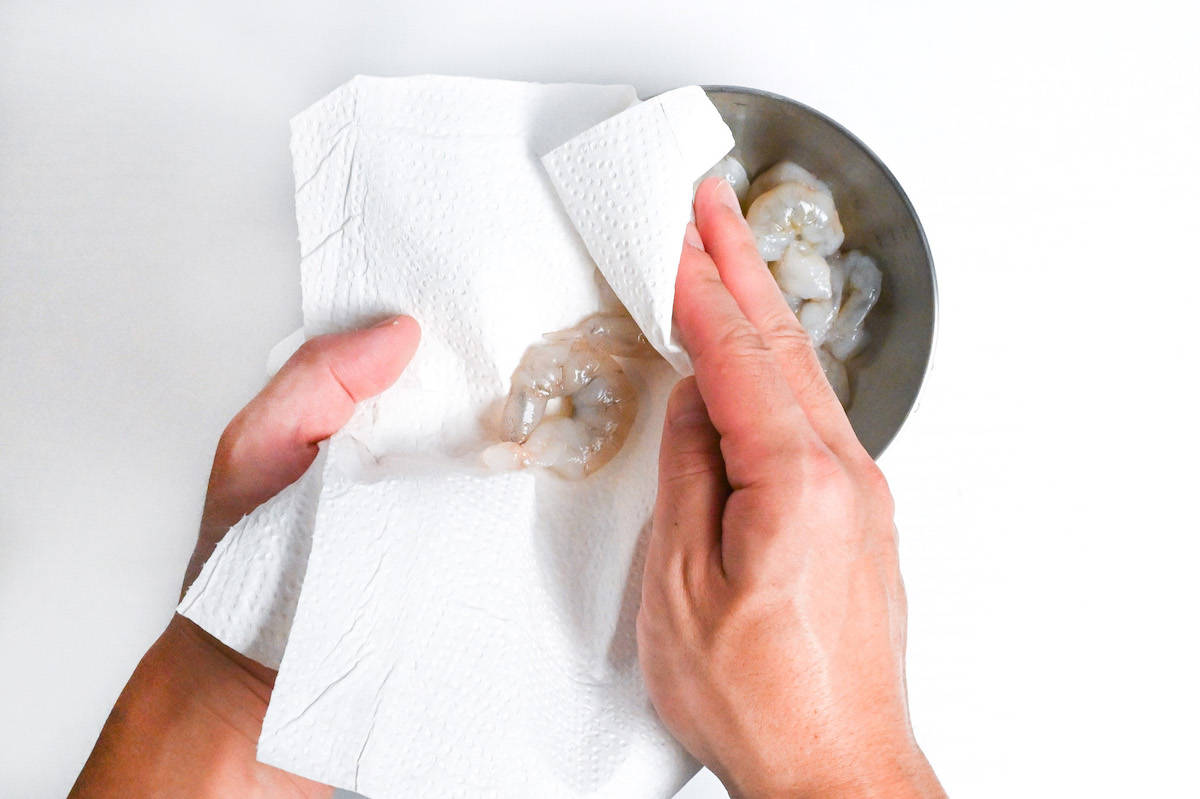
Rinse the shrimp thoroughly with fresh water and pat them dry with kitchen paper. This will remove any dirt or debris and hugely improve the flavor of your shrimp!
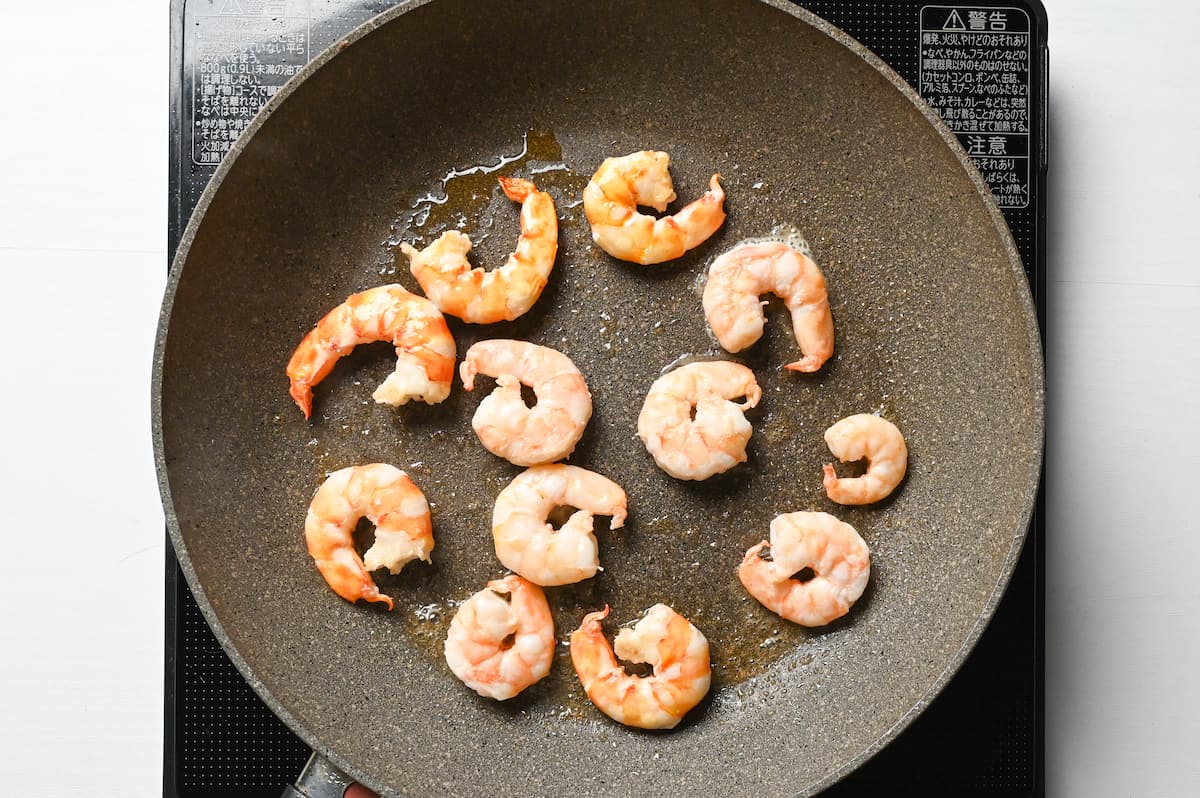
Preheat a large frying pan on medium and once hot, add a drizzle of oil. Add the shrimps and fry until they turn pink.
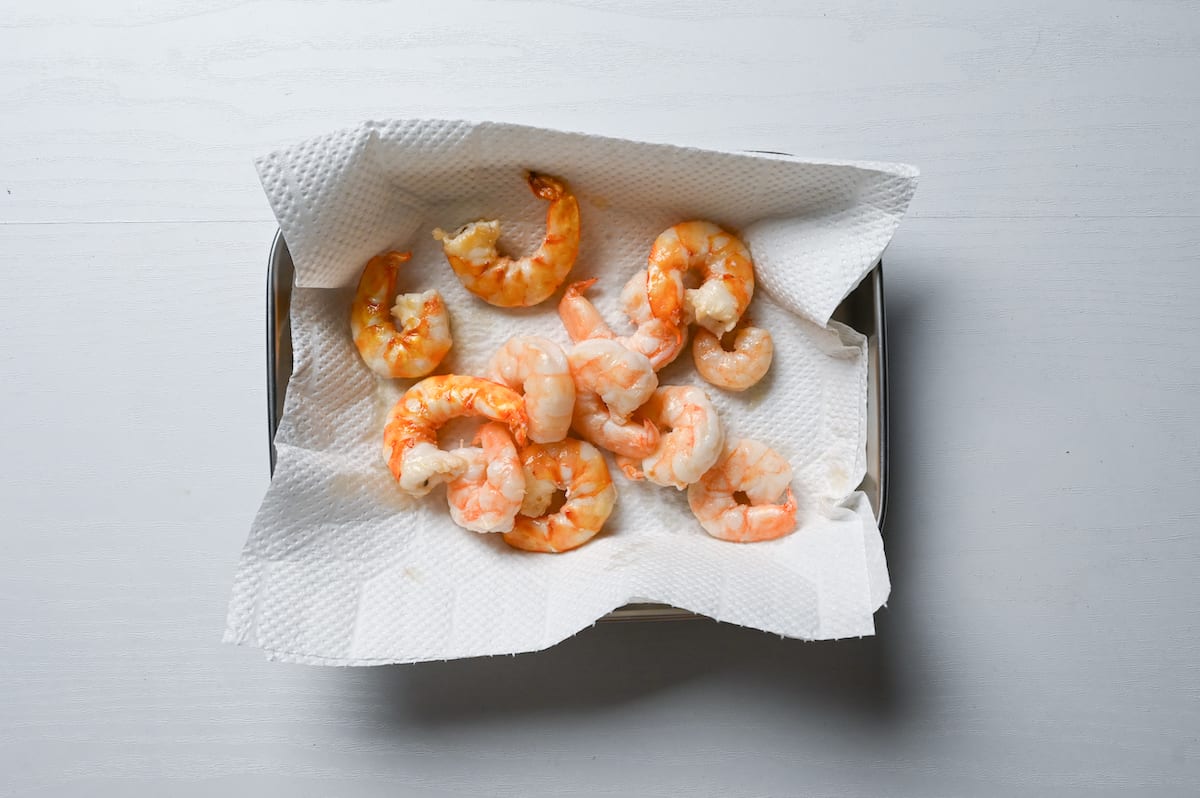
Transfer the shrimps to a plate or container lined with kitchen paper (this is to absorb any excess oil) and set aside for later.
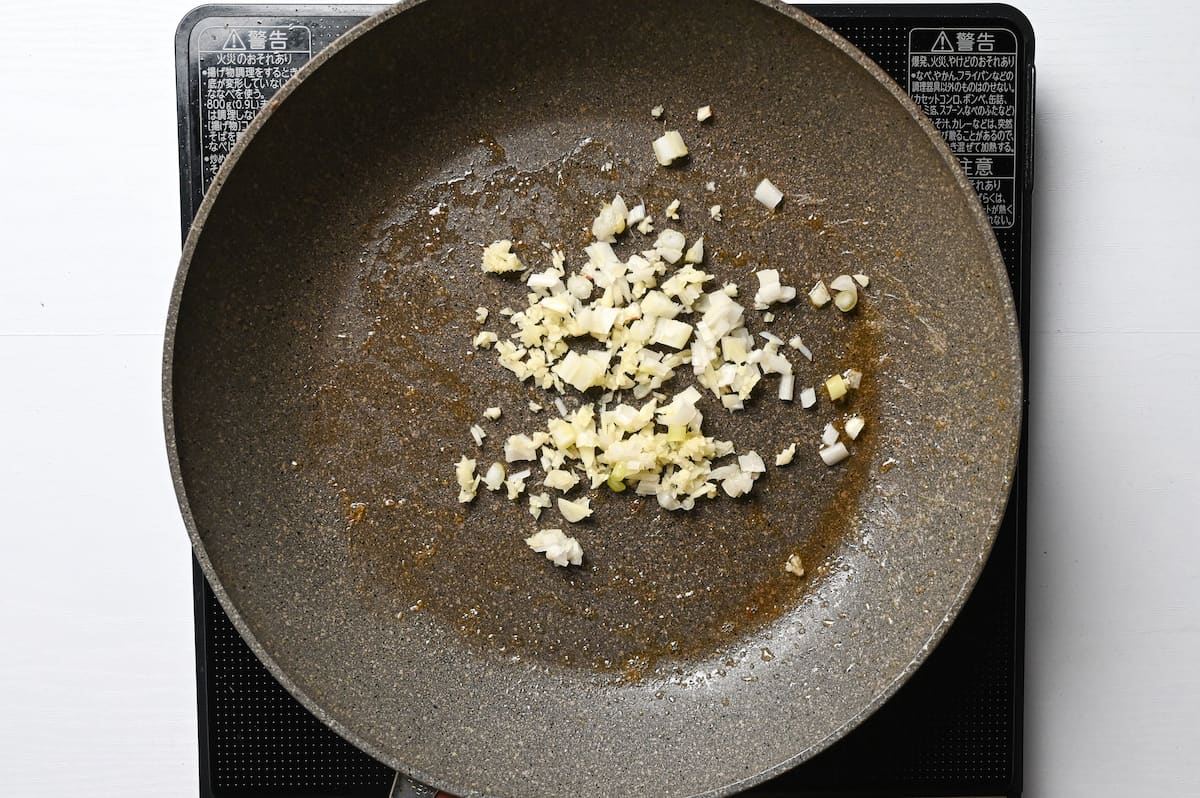
Using the same pan, lower the heat and add finely diced garlic, fresh ginger and the white part of a spring onion. Be careful not to let them burn or brown too much as this can make the oil taste bitter. Add more oil if necessary.
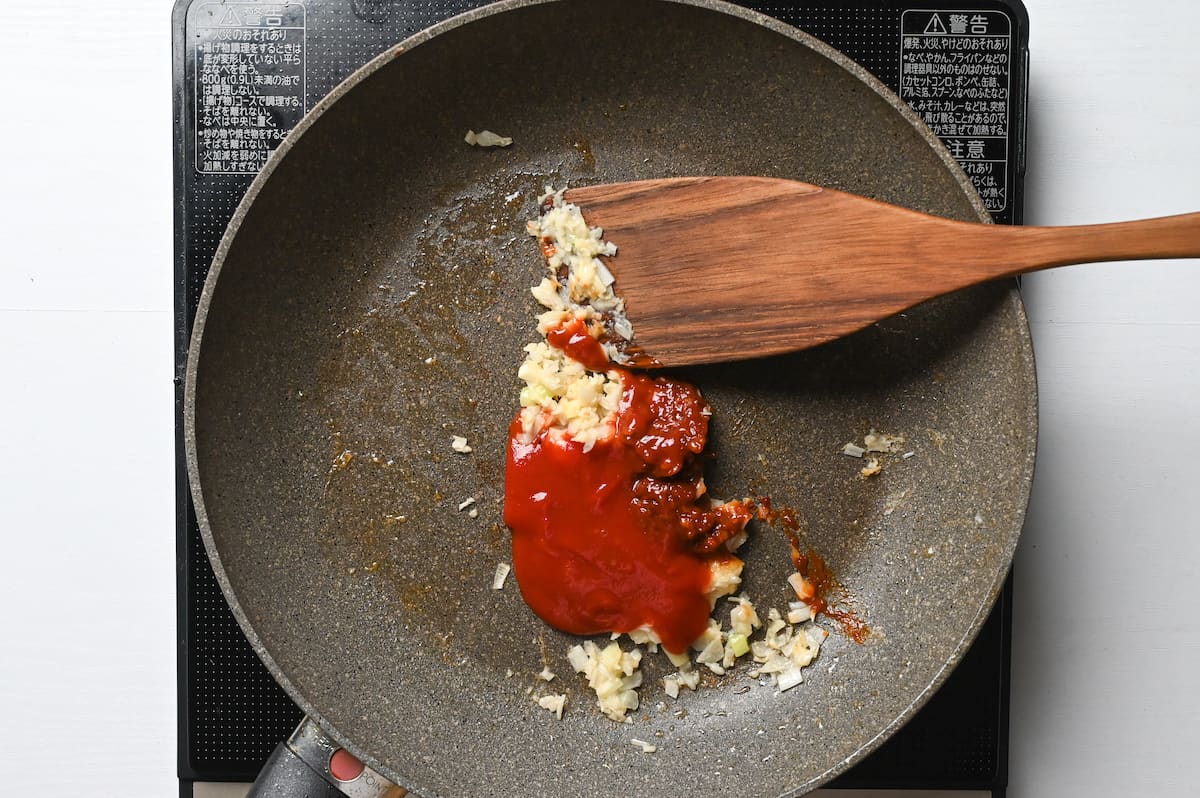
Once fragrant, add the ketchup and doubanjian. Mix thoroughly and fry for about 1-2 minutes.

Next, add the water and chicken stock powder. Turn up the heat to medium, mix well and bring it to a boil.
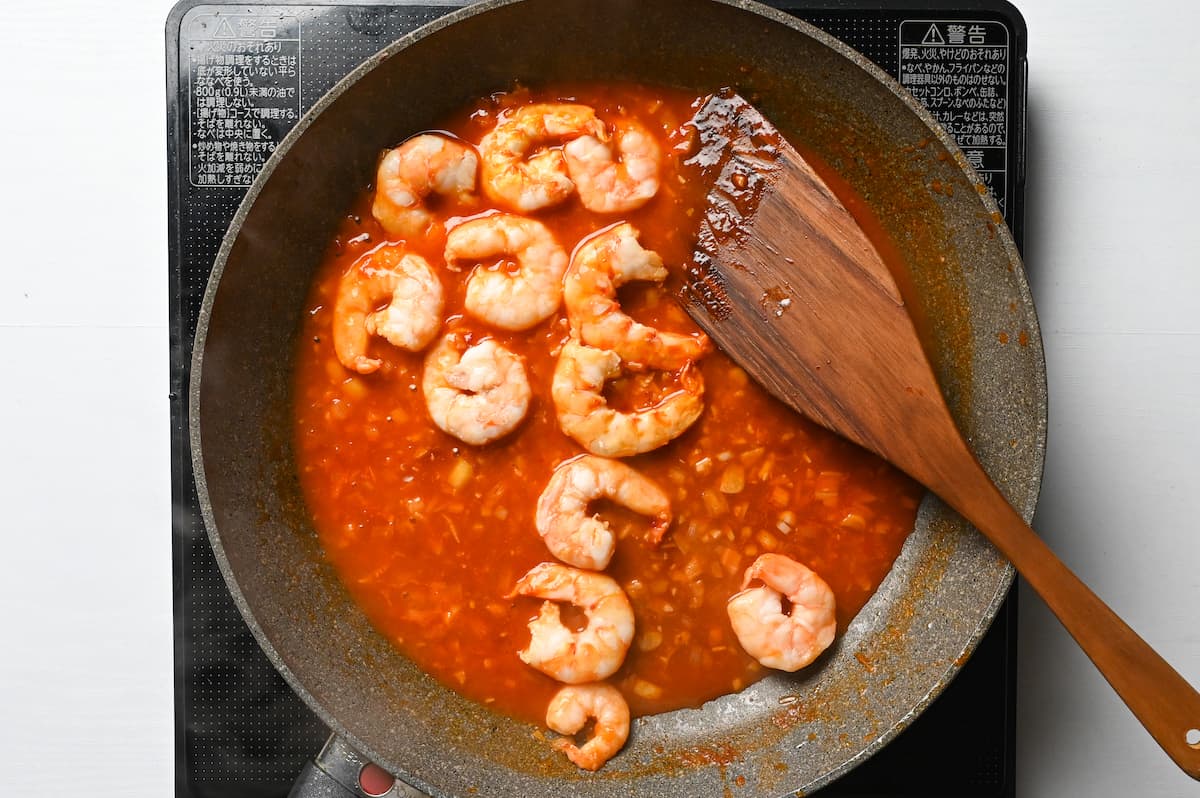
Once the sauce is bubbling, add the shrimps back in and lower the heat back down to a simmer.
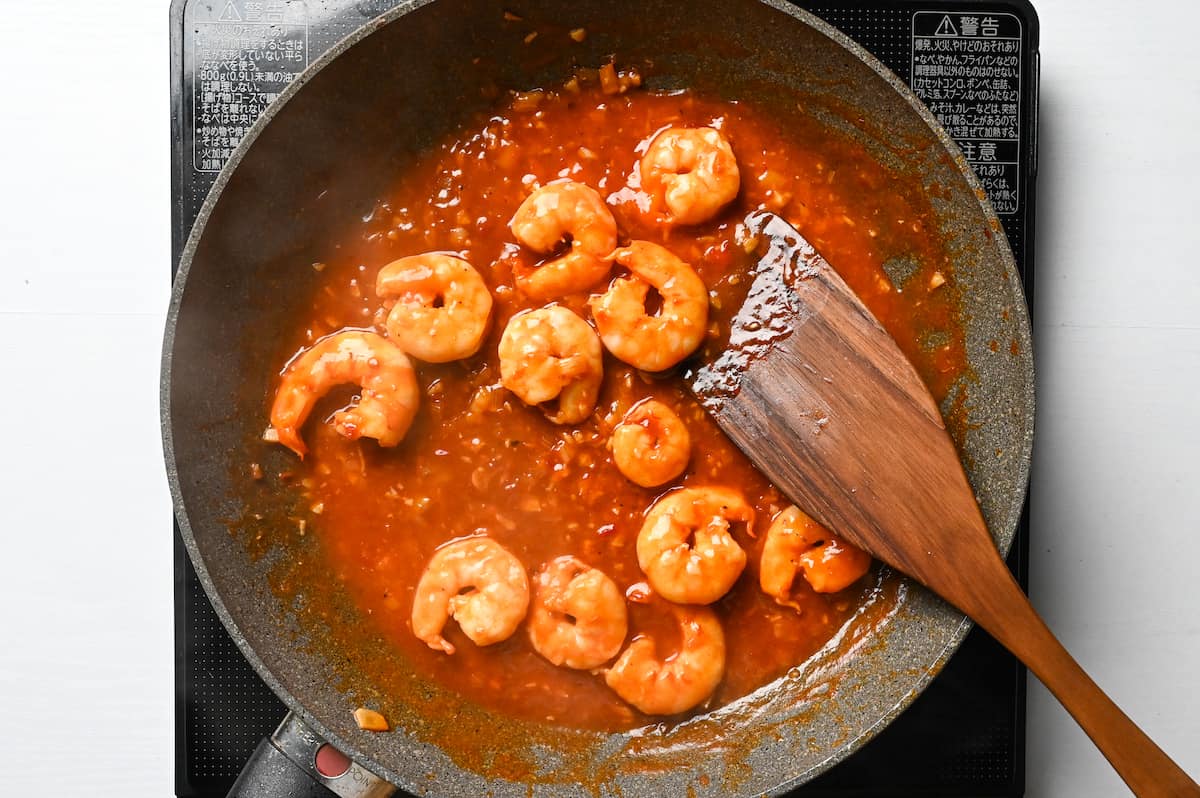
In a small bowl, mix 1 tbsp of cold water with 1 tsp of cornstarch to make a slurry. Pour the slurry into the pan and mix well. The slurry helps to thicken the sauce and make it glossy.
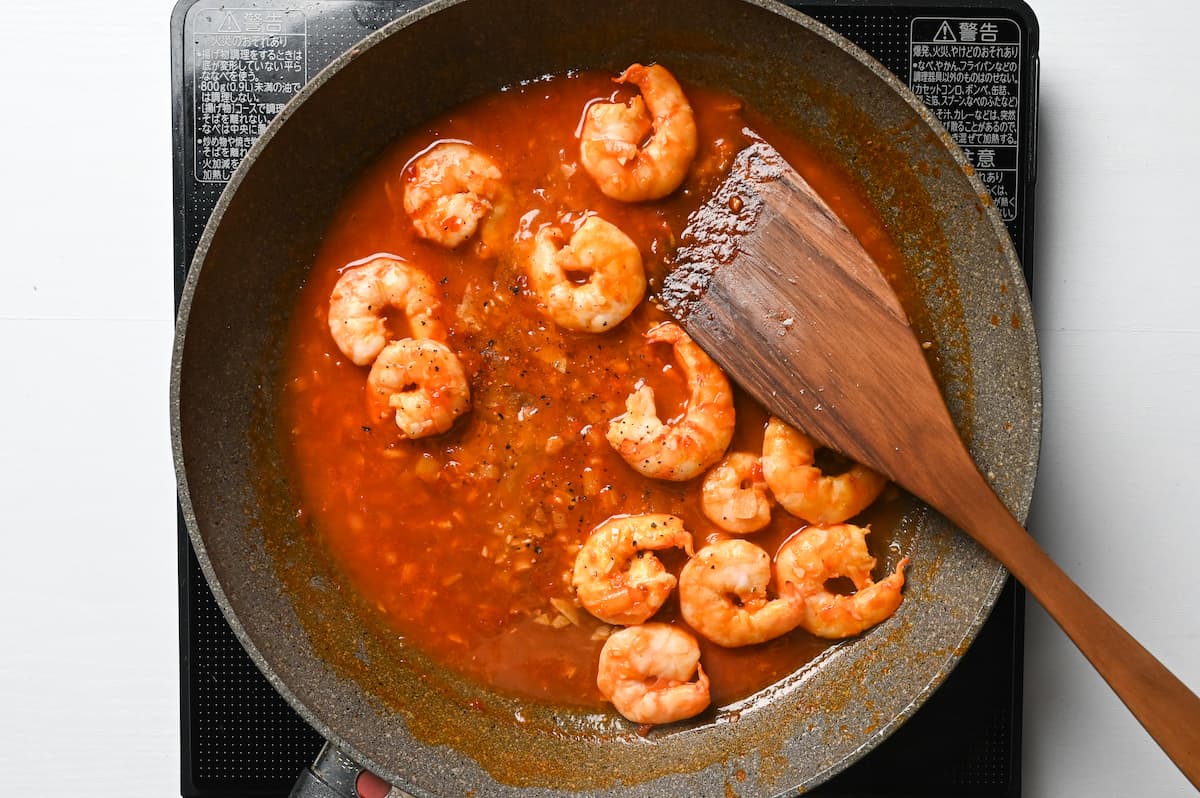
Sprinkle with a pinch of salt, pepper and sugar to taste, mix well and continue to simmer until thickened.
Once thick and glossy, remove the pan from the heat.

Transfer the ebi chili to a serving dish and sprinkle with chopped spring onion (green part), sesame oil and chili threads for decoration. Enjoy!
Jump to Full Recipe Measurements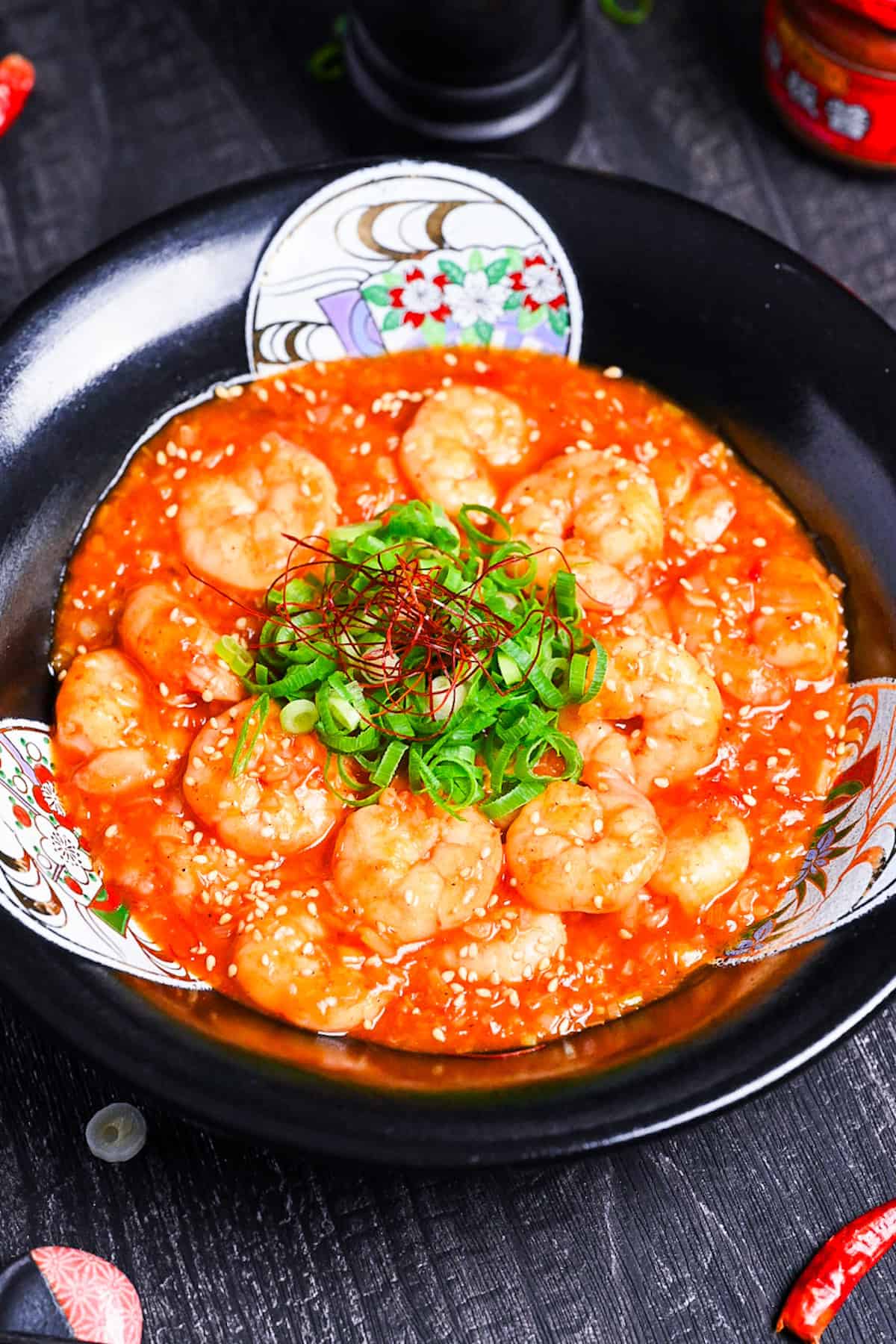
How to Store
Ebi chili can be stored in a sealed container in the fridge for 2-3 days or divided into portions and frozen for 2-3 weeks.
It can be reheated on the stove or in the microwave, although reheating might cause the texture of the shrimp to deteriorate. Make sure to reheat until piping hot before eating.
Storage summary
Room temperature – Not recommended.
Refrigerated – 2-3 days.
Frozen – 2-3 weeks.

FAQ
It is believed that Ebi Chili appeared in Japan around when a Chinese chef named Jianmin Chen opened a Chinese restaurant in 1958. One of his specialty dishes was a Sichuan dish known as “Kanshao Sharen” (乾焼蝦仁), which is usually made with boiled shrimp and Chinese spicy bean paste.
Since Japanese people were not accustomed to the heat of Chinese spicy bean paste, Chen made the dish with ketchup, sugar and egg yolks to soften the spiciness and adapt it to the tastes of the Japanese people. Since then, ebi chili has become one of the most popular Chinese-inspired dishes in Japan!
Chuka Ryori is a style of Japanese cooking that is inspired by Chinese cuisine. The term “Chuka Ryori” (中華料理) literally translates to “Chinese cuisine” in Japanese. It was introduced to Japan during the Meiji era (1869-1912) and has since become one of the most popular cuisines in Japan.
Chuka Ryori dishes typically feature a blend of Chinese and Japanese cooking techniques and ingredients. Just like the case of ebi chili, many famous Chuka dishes were created by Chinese chefs living in Japan. The dishes are usually savory and often incorporate noodles, vegetables, seafood, and meat. Some popular Chuka Ryori dishes include gyoza (dumplings), ramen and chahan (fried rice).
Within Chuka Ryori, Sichuan inspired dishes are particularly popular in Japan. This may come as a surprise since Sichuan cuisine is known for its famous hot and spicy “Sichuan Pepper.” However, Sichuan dishes in Japan are adapted to be milder and are popular home-cooked dishes that are eaten by the whole family including children. Some examples include ebi chili, mabo dofu (mapo tofu) and tantanmen (spicy sesame ramen).
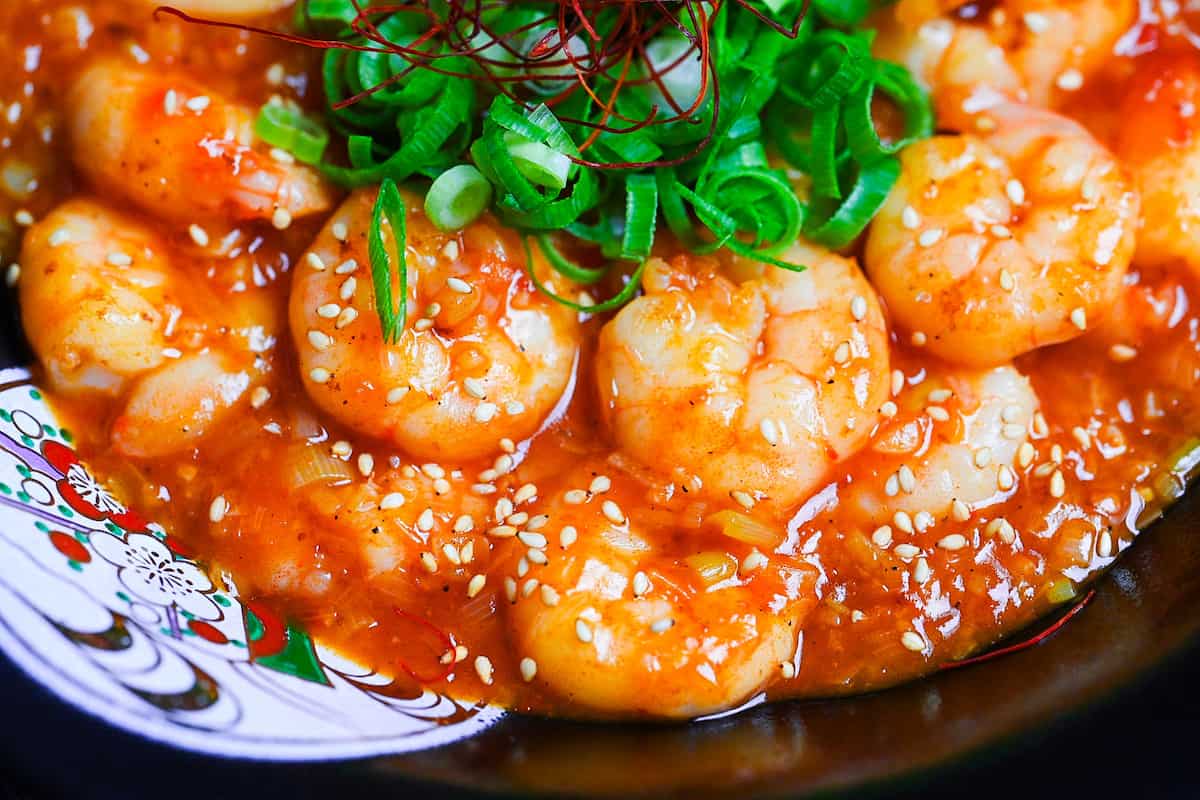
I hope you enjoy this Ebi Chili recipe! If you try it out, I’d really appreciate it if you could spare a moment to let me know what you thought by giving a review and star rating in the comments below. It’s also helpful to share any adjustments you made to the recipe with our other readers. Thank you!
More Japanese Shrimp Recipes
- Ebi Furai (Deep-fried Shrimp with Panko)
- Shrimp Yaki Udon (Shio Lemon Shrimp Udon Stir Fry)
- Crispy Japanese Shrimp Tempura (Ebiten)
- Ebi Mayo (Fried Shrimp in Mayonnaise Sauce)
Want more inspiration? Explore my Shrimp Recipe Roundup Post for a carefully selected collection of tasty recipe ideas to spark your next meal!
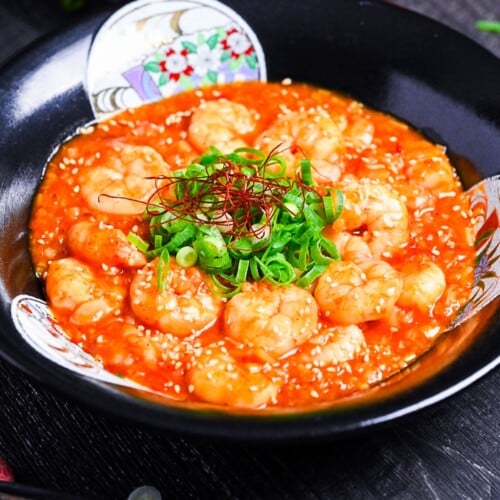
Ebi Chili (Japanese Shrimp in Chili Sauce)
Ingredients
- 250 g shrimp peeled and deveined
- 2 pinches salt
- 1 tsp cornstarch
- 2 tbsp cooking oil
- 1 tbsp ginger root finely diced
- 2 cloves garlic finely diced
- 30 g green onion white part, finely diced
- 2 tbsp tomato ketchup
- 1 tsp chili bean sauce toban djan, use double for a spicier ebi chili
- 150 ml water
- 1 tsp Chinese-style chicken bouillon powder (granules)
- 1 tsp cornstarch to make slurry
- 1 tbsp cold water to make slurry
- 1 pinch salt
- 1 pinch ground black pepper
- 1 pinch sugar
Garnish (optional)
- 1 tsp finely chopped green onions green part
- 1 tsp white sesame seeds
- ½ tsp chili threads
Instructions
- Place 250 g shrimp in a bowl and rub 1 tsp cornstarch and 2 pinches salt over the surface. Once evenly covered, leave for 1-2 minutes.

- Wash thoroughly with cold water and pat dry with kitchen paper.

- Heat a large pan on medium and once hot, add 2 tbsp cooking oil and the shrimps. Fry until the shrimps turn pink.

- Once cooked, transfer the shrimps to a container lined with kitchen paper.

- Lower the heat and in the same pan, add 1 tbsp ginger root, 2 cloves garlic and 30 g green onion. Stir fry until fragrant.

- Next, add 2 tbsp tomato ketchup and 1 tsp chili bean sauce. Mix and fry for 1-2 minutes.

- Add 150 ml water and 1 tsp Chinese-style chicken bouillon powder (granules), turn up the heat to medium and bring to a boil. Stir occasionally.

- Once boiling, lower the heat down to a simmer and add the shrimps back in.

- In a small bowl, mix 1 tsp cornstarch with 1 tbsp cold water to make a slurry. Add it to the pan along with 1 pinch salt, 1 pinch ground black pepper and 1 pinch sugar.

- Mix and continue to simmer until the sauce becomes thick and glossy.

- Transfer to a serving dish and top with 1 tsp finely chopped green onions, 1 tsp white sesame seeds and ½ tsp chili threads.

- Enjoy!
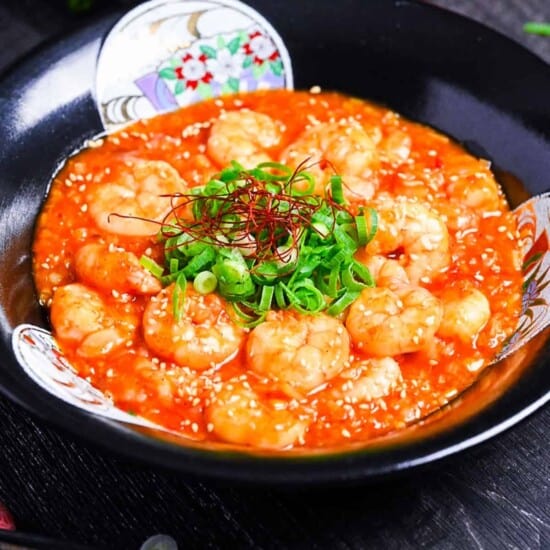



I made this dish following the recipe with no deviations and it came out great! Thank you for posting!
Thank you for trying the recipe and giving such a generous rating, I’m so glad you liked it!